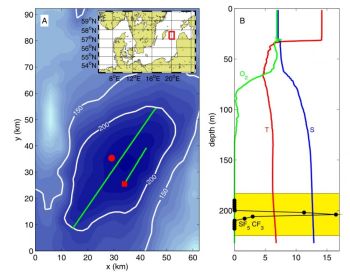
Baltic Sea Tracer Experiment

One of the outstanding questions for the Baltic Sea ecosystem is how physical and bio-geochemical properties of the deep layers communicate with the surface mixed layer where production takes place. In a joint project of IOW and GEOMAR (Kiel), we investigated these mixing processes in the framework of the Baltic Sea Tracer Release Experiment (BaTRE), conducted in the years 2007-2010.
In collaboration with the tracer research group of Jim Ledwell (WHOI), a new type of tracer, CF3SF5, was injected in September 2007 into the deep waters of the Eastern Gotland Basin with the help of the new Oceanic Tracer Injection System (OTIS) built for this project (see Umlauf et al. 2008). The figure to the right shows the study area, the vertical distribution of the tracer (markers in highlighted area), and some hydrographic parameters as measured approximately two weeks after the injection.
The experiment was accompanied by extensive turbulence measurments in order to obtain direct mixing estimates for comparision with the basin-scale mixing inferred from the vertical spreading of the tracer cloud. Combined with additional moored instrumentation (ADCPs, current meters, CTD loggers), a coherent data set could be obtained. A key result of this project was the observation that deep-water mixing in the central Baltic Sea occurs almost exclusively in the turbulent boundary layers on the topographic slopes of the basin (Holtermann et al., 2012; Holtermann and Umlauf, 2012). This finding challenged the traditional view about how mixing works in the Baltic Sea, and how it should be parameterized in numerical models (Holtermann et al., 2014).